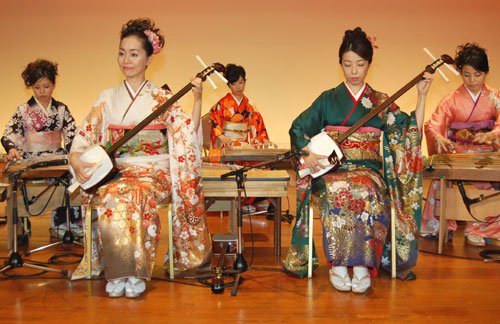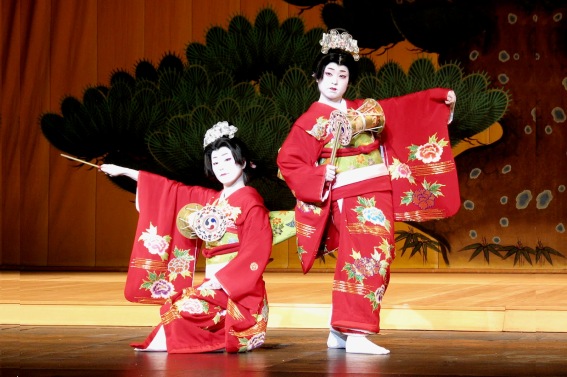The earliest forms of music were drums and flute music accompanying the kagura shrine dances.
Meanwhile with the introduction of Buddhism to Japan in the 6th century, Buddhist rites and liturgical chants gave rise to kabuki music of the Edo period (1600-1868).
From the 17th century, the shamisen (three-stringed plucked lute) came to the fore, providing the lively rhythm that dominated the sounds of the popular kabuki and bunraku theaters.
Japanese musical instruments are dominated by plucked string, flute and percussion instruments.
Every region of Japan has its own folksongs – minyo – which, depending on daily activities of the traditional community, may be rice-planting songs, boatman’s songs, sake-making songs, or grass-cutting songs, plus a variety of songs sung at parties.
Among folk music styles, Okinawan music is experiencing a strong revival.

Japanese Dance
There is a tremendous diversity in traditional Japanese dance, from court and religious dance to the ritualistic noh dance-drama and theatrical kabuki dance. In modern times, Japan’s avant-garde butoh dance has also attracted international interest.
Historically, kagura (dance of the gods) is the oldest form of dance in Japan. Originally performed by shamans, its influence is perceived in all Shinto dances performed at shrines today to appease or attract the favor of the deities.

Shosagoto dances (originally for the roles of onnagata female impersonators) became the most important type of kabuki dance, differentiated according to whether a lyrical (nagauta) or narrative (tokiwazu-bushi, tomimoto-bushi, kiyomoto-bushi) style of music was used to accompany it.
In the modern era, Fujikage Shizue (1880-1966) established the Shinbuyo (New Dance) movement under the influence of Western dance, which gave ordinary people the opportunity to perform kabuki dance as an independent art form. This led to a proliferation of dance schools (about 168 today) where pupils are mostly women.
G. PavithaSri
B.Sc Psychology
The color of their costume seems to be dull.
Daksha
LikeLike
I think Different costumes are worn in the various dance styles.
Rathika
LikeLike
The movements in the dance are slow and include specific and gentle gestures and movements.
Neha
LikeLike
Is Kabuki a Classical Japanese drama?
Akanksha
LikeLike
I guess, Japan has high refined traditional arts.
sharadha
LikeLike